You’ll find our in-depth look at 8.6 Blackout ballistics from manufacturers who load 8.6 Blackout ammo.
Click on the links below to skip to your preferred ammo company and find the data you need for your favorite factory load.
Table of Contents
- 8.6 Blackout Ballistics Charts
- Callaway Ammunition Ballistics – 8.6 Blackout
- Dirty Bird Industries Ammunition Ballistics – 8.6 Blackout
- Fort Scott Munitions Ballistics – 8.6 Blackout
- Gorilla Ammunition Ballistics – 8.6 Blackout
- 8.6 Blackout Ballistics Trajectory Chart
- How Do 8.6 Blackout Ballistics Compare to Other Rifle Cartridges?
- Frequently Asked Questions
8.6 Blackout Ballistics Charts
Jump to an ammo company: Callaway | Dirty Bird | Fort Scott | Gorilla
Callaway Ammunition Ballistics – 8.6 Blackout
Callaway Ballistics 8.6 Blackout 285 grain ELD-M Ballistics Chart
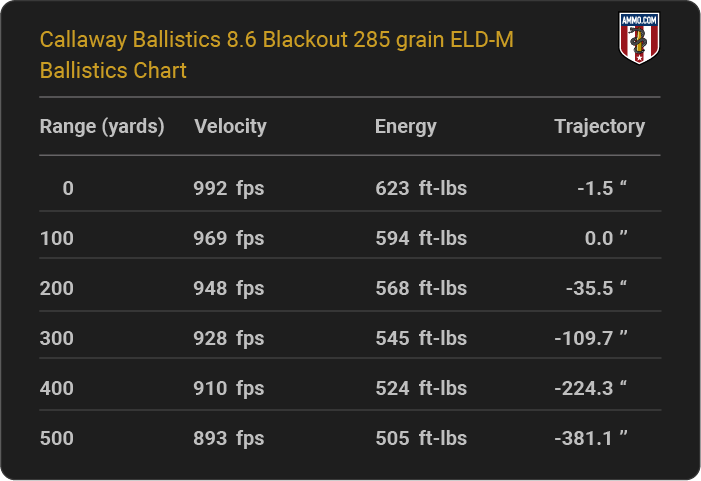
(Back to Top)
Dirty Bird Industries Ammunition Ballistics – 8.6 Blackout
Dirty Bird 8.6 Blackout 300 grain SMK Ballistics Chart
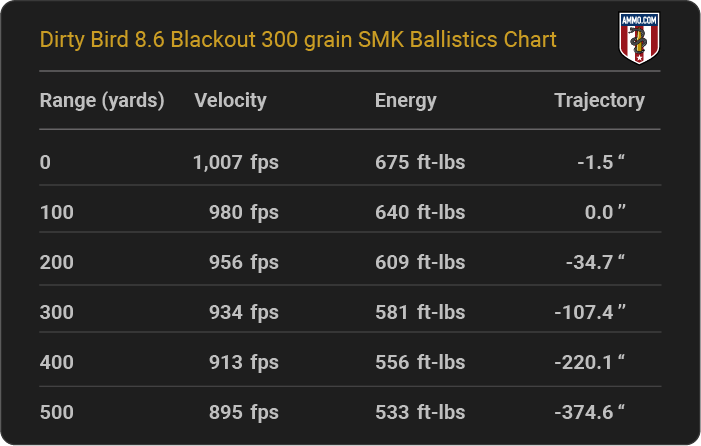
(Back to Top)
Fort Scott Munitions Ballistics – 8.6 Blackout
Fort Scott Munitions 8.6 Blackout 285 grain TUI Ballistics Chart

(Back to Top)
Gorilla Ammunition Ballistics – 8.6 Blackout
Jump to a ballistics chart: Gorilla 8.6 Blackout 210 grain TSX | Gorilla 8.6 Blackout 300 grain SMK | Gorilla Silverback 8.6 Blackout 285 grain Fracturing | Gorilla Subsonic Hunting 8.6 Blackout 342 grain Pork Shredder CHP
Gorilla 8.6 Blackout 210 grain TSX Ballistics Chart

Gorilla 8.6 Blackout 300 grain SMK Ballistics Chart
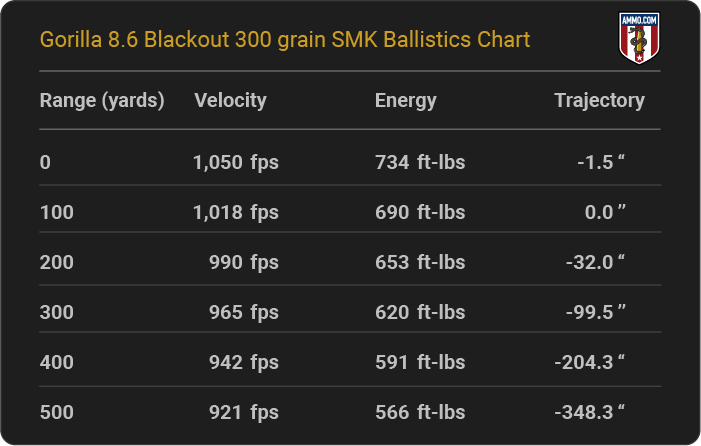
Gorilla Silverback 8.6 Blackout 285 grain Fracturing Ballistics Chart
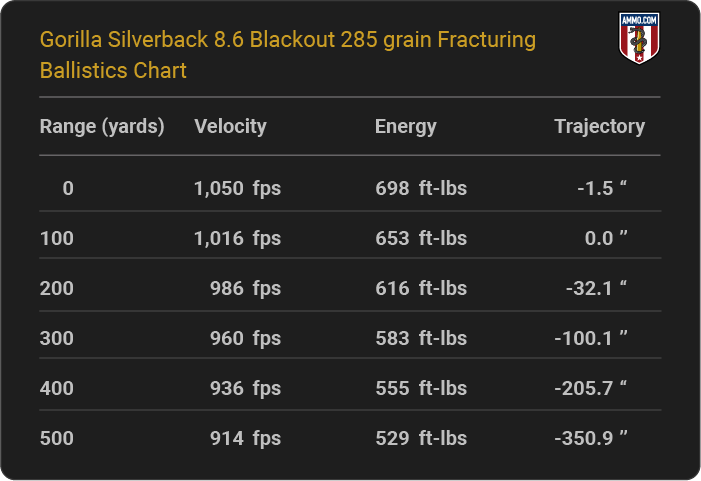
Gorilla Subsonic Hunting 8.6 Blackout 342 grain Pork Shredder CHP Ballistics Chart
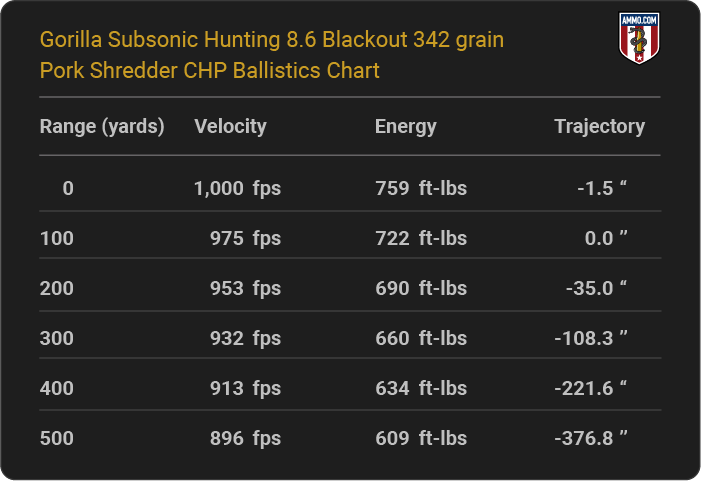
(Back to Top)
Administrative Note: The information above comes from the manufacturer and is only informational. The actual ballistics obtained with your firearm can vary considerably from the advertised ballistics. Also, ballistics can vary from lot to lot with the same brand and type load. When manufacturer ballistic data was unavailable, ballistics were calculated using a ballistics calculator.
8.6 Blackout Ballistics Trajectory Chart
The trajectory measures a bullet’s flight to its target based on bullet drop (in inches). Below, you’ll find an 8.6 Blackout bullet drop chart that gives you a general idea of the 8.6 Blackout trajectory.

Note: The chart above is an example of one 8.6 Blackout load, and actual ballistic performance may vary depending on bullet weight, lot, barrel length, and environmental conditions while shooting.
The 8.6 Blackout is not what we shooters consider a long-range round. As you can see, it quickly drops off after 100 yards, which is abysmal compared to a round like the 6.5 PRC or even the 300 BLK.
8.6 Blackout Muzzle Velocity (FPS)
Muzzle velocity is the bullet’s speed when it leaves the firearm barrel. It’s measured in feet per second (fps). Generally, a longer barrel length allows for more powder to burn, generating a higher muzzle velocity. Bullet design and weight will also affect muzzle velocity.
You should expect a muzzle velocity of around 1,000 fps for most 8.6 Blackout ammo, including the Gorilla Subsonic Hunting 8.6 Blackout 342-grain Pork Shredder CHP. However, the Gorilla 8.6 Blackout 210gr TSX has a much higher-than-usual muzzle velocity of 1,970 fps. This is partly due to the lighter bullet, which takes more powder to propel heavier bullets faster.
8.6 Blackout Muzzle Energy
Muzzle energy is how much force a bullet delivers to its target at a given range, measured in foot-pounds of energy (ft-lbs). The terminal performance of a round will depend on whether it’s a supersonic load or subsonic load, bullet weight, bullet design, barrel length, and several other factors.
The muzzle energy of the 8.6 Blackout is nothing to gasp at, generally hitting 623 ft-lbs to 729 ft-lbs of energy. However, the Gorilla Ammunition with a 210gr Barnes TSX has a much higher muzzle energy of 1,810 ft-lbs of energy.
How Do 8.6 Blackout Ballistics Compare to Other Rifle Cartridges?
Ballistic performance depends on an incredibly high amount of factors from the gun, whether it’s a bolt action rifle or a semi-auto rifle like the AR-10 platform, and barrel length; a short barrel will cause the bullet to react differently than a long barrel, plus all the environmental factors and the ammo.
This is why results vary considerably even amongst the same caliber bullets, making comparing different calibers much more difficult.
However, we’ve compared a couple of common rifle calibers to the 8.6 Blackout just to give you an idea of its performance capabilities.
8.6 Blackout vs. 223 Rem
First things first: When comparing these two calibers, we must be fully aware of the bullets’ size differences. The heaviest 223 Remington bullet is 77 gr, while the 8.6 BLK is loaded with bullets as heavy as 342 gr. So, with this in mind, the ballistics will be drastically different.
The muzzle velocity of a 77gr 223 Rem bullet is 2,750 fps, and one of the fastest 8.6 Blackout bullets is a 185 gr bullet with a muzzle velocity of 2,200 fps. But when we step up to the heaviest bullet for the 8.6 Blackout (342 grains), the velocity is more than cut in half to 1,000 fps.
The 8.6 Blackout also has a low muzzle velocity compared to the 223 Remington. The same 77 gr 223 Rem bullet has a muzzle velocity of 1,293 ft-lbs, double most 8.6 Blackout rounds. However, the 210 gr TSX 8.6 BLK bullet has a higher muzzle energy of 1,810 ft-lbs; the 223 Rem cannot produce this much muzzle energy.
Because the 8.6 Blackout was designed to be shot through a carbine with a suppressor, the trajectory is pretty embarrassing, to say the least.
The 210 grain TSX 8.6 BLK bullet is the flattest shooting 8.6 Blackout round, and when zeroed in at 100 yards, it has 9.4 inches of drop at 200 yards and 129.9 inches of drop at 500 yards. When zeroed in at 200 yards, yes, the 223 Remington shoots flat enough to zero in at 200 yards; the bullet drops 54.73 inches at 500 yards and passes over 600 yards before it drops more than 130 inches.
The differing intended purposes can account for the drastic differences. The 8.6 Blackout is an excellent close-quarters self-defense and a close-range big game hunting rifle. Meanwhile, the 223 Rem is fun to take varmint hunting and plink with at the range.
8.6 Blackout vs 6.5 Creedmoor
The 8.6 Blackout and 6.5 Creedmoor are the closest you can get to having an even comparison regarding the 8.6 BLK. This is because the 6.5 Creedmoor case is the parent case of the 8.6 Blackout.
Some shooters claim the 8.6 Blackout is the big brother to the 6.5 Creedmoor and 300 Blackout; this is primarily due to the size of the bullet each caliber shoots and not based on the ballistics.
The 6.5 Creedmoor Hornady ELD-Match 120 gr bullet has a muzzle velocity of 2,910 fps, and the closest the 8.6 Blackout comes to that is 1,970 fps with a 210 gr Barnes TSX bullet.
Regarding muzzle energy, the 6.5 Creedmoor sits around 2,400 ft-lbs whether you’re shooting the 120 grain or 140 grain bullet. However, the 8.6 Blackout hovers around 700 ft-lbs of energy and tops out at 1,810 ft-lbs with a 210 gr bullet.
I’m sure you know what’s coming concerning the trajectory. To be fair, the 6.5 Creedmoor was designed for long-distance shooting, whereas the 8.6 Blackout was not.
When zeroed in at 100 yards, the 210 grain 8.6 BLK bullet drops over 9 inches by the 200-yard mark and basically 130 inches by the 500-yard mark. In contrast, the 6.5 Creedmoor can be zeroed in at 200 yards and only drops 46 inches by 500 yards.
Frequently Asked Questions
The team at Ammo.com has gathered and answered some of the most commonly asked questions we receive regarding 8.6 Blackout ballistics.
What is the effective range of the 8.6 Blackout?
The effective range of the 8.6 Blackout is 1,000 yards with supersonic rounds, but 300 yards tends to be the max for most shooters as the trajectory is terrible.
What is the supersonic velocity of an 8.6 Blackout?
The supersonic velocity of an 8.6 Blackout round is 2,400 fps, according to Faxon Firearms.
Is 8.6 Blackout the same as 8.6 Creedmoor?
Yes, the 8.6 Blackout is the same as the 8.6 Creedmoor.
What barrel length is recommended for optimal performance with the 8.6 Blackout cartridge?
A 12” barrel is the recommended barrel length for optimal performance with the 8.6 Blackout cartridge. However, to shoot further distances, stepping up to a 16-inch barrel is not a bad idea.
What barrel twist rate is recommended for the 8.6 Blackout?
A 1:3 in or 1:4 in barrel twist rate is recommended for the 8.6 Blackout.










































![Air gun 101: The differences between .177 & .22 – Which jobs they do best ? [Infographic]](https://airgunmaniac.b-cdn.net/wp-content/uploads/2024/11/1773-150x150.jpeg)
